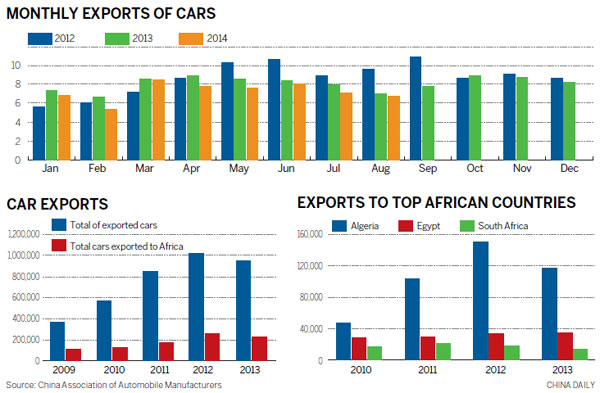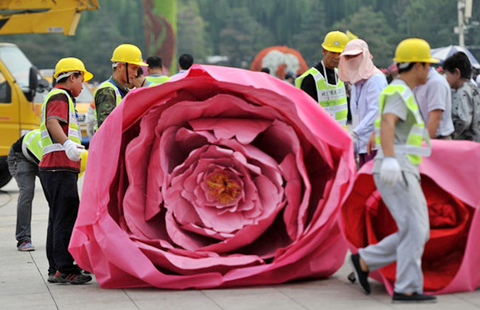
|
A production line at Chery Automobile Co, one of the country's industry leaders, based in Wuhu, Anhui province. Zhang Yanlin / for China Daily |
Auto giant SGMW marked a new chapter in the story of Chinese companies selling cars to Africa.
The three-way joint venture, between one of the country's market leaders, SAIC Motor Corporation; Liuzhou Wuling Motors, the pickup truck and small commercial vehicle manufacturer; and General Motors China, was the first to sell know-how and skills, rather than parts or completed vehicles to the continent.
It signed an agreement with GM Egypt, an affiliated company, for it to use technology and manufacturing processes related to its popular model N300 passenger van, along with the services of its engineers and managers.
GM Egypt then introduced the N300 from SGMW in 2012, branded as the Chevrolet Move.
"For the first time, we started to earn money from selling intellectual property," a spokesman for the company told China Daily, "instead of paying for them."
Based in Liuzhou, the Guangxi Zhuang autonomous region, with minivans and MPVs at the core of its products, SGMW made 1.6 million vehicles in 2013 under the Wuling and Baojun marques, to become the largest automaker by output in China. It plans to produce 100 billion yuan ($16.3 billion) worth of products next year.
GM Egypt's plant started mass production in 2012, using parts imported from SGMW's Qingdao plant, with an eventual annual production target of 5,000 vehicles.
From January to July this year, it sold nearly 2,400 in Angola, Algeria, Egypt, Nigeria and other African countries.
The N300, sold as the Wuling Rongguang, has already achieved cumulative sales of 2.2 million in China since being launched in 2010.
Chinese carmakers, however, have a history of coming late to Africa.
When the first "made in China" vehicles arrived for sale there in the 1990s, they found the continent already flooded with used European and Japanese cars, trucks and vans.
Since then many have struggled to compete against not only well-established Western rivals, but other aggressive Chinese and Indian competitors, too.
A recent United Nations report shows that African manufacturing contributed just 10 percent to the continent's total GDP and only 1 percent of the world's manufacturing value.
While this lack of factory capability remains a big issue in Africa, it does, however, offer opportunities for countries that are eager to export their products and technologies.
And although Chinese car brands lag well behind some of the country's other highly recognizable international brand names such as electronic giants ZTE and Huawei, they are slowly starting to establish themselves in this vast, untapped market.
International carmakers traditionally need to go through four stages to take root in a foreign country: They export their products there; create local assembly facilities with parts shipped from home; establish a local production plant; and finally open local research and development sites.
Global vehicle brands such as Volkswagen and Toyota are already at the most advanced stage in major developing countries. But for Chinese automakers, their African journey has really just begun.
Even Chery Automobile Co and Great Wall Motors, two of the country's industry leaders, have only just started to establish African assembly plants.
For many Chinese brands, the African market is still just an embryonic, and still-remote export destination.
Ironically, China's auto pioneers in Africa tend to be those who were not so successful at home.
Hebei Zhongxing Automobile Co, branded as ZX Auto, a smaller Chinese producer of SUVs and pickup trucks, is a good example.
Pickups are categorized as passenger cars in developed countries, but in China they are labeled as trucks and therefore face various restrictions on city roads.
In ZX Auto's own Hebei province alone there are seven pickup makers that have previously engaged in some brutal price battles.
But in June 2012, the company's first Komodo truck rolled smoothly off the production line at its plant in Cairo. It already has plants in Russia, where it has been since 2006, and in other markets including Jordan.
Chery's biggest overseas market so far is Brazil, while Great Wall's is Russia.
Last year Chery shipped around 180,000 cars overseas, 10,000 of which were to Brazil, where its market share still remains less than 1 percent.
Great Wall likes to call Russia its second home market, with deliveries there last year of 20,000, out of its total overseas shipment of 73,000 vehicles.
In 2013, total Chinese auto sales in Africa were 153,000 vehicles, including 117,000 to Algeria and 35,500 to Egypt.
Considering that German car giant Volkswagen sold more than 3 million cars in China last year, those African performances pale in comparison.
Some Chinese brands have rightly claimed that African consumers are still to truly embrace the age of the car, but they cannot deny a huge disparity still exists between Western and Chinese brands in terms of overseas presence.
Patrick Blain, president of the Paris-based International Organization of Motor Vehicle Manufacturers - which coordinates communication among major manufacturers, as well as a number of international car shows - says Chinese brands are making strong efforts to go global, but are yet to gain a position befitting an economy of China's size.
"The situation has to change, and this could happen faster than many expect," he says.
"Customers around the world are wanting to see better-quality Chinese products, and I believe its automakers will become more active on the world stage."
Although Chinese carmakers are yet to generate any great income from Africa, they certainly cannot afford to neglect a consumer market with 54 countries and 700 million people for too much longer.
Dong Yang, secretary-general of the China Association of Automobile Manufacturers, says the next handful of years will be critical for Chinese companies to take root in Africa, and in other overseas markets.
According to the association's statistics, China exported 71,700 vehicles in July, a drop of 11.5 percent on the previous month, and down 10.7 percent year-on-year.
Passenger cars accounted for 39,600 units, down 16.3 percent on June, and 21.5 percent year-on-year with commercial vehicles totaling 32,100 units, down 4.7 percent in June and but up 7.4 percent year-on-year.
Despite these challenging figures, Dong insists he expects to see "one or two companies making it into the world's top 10" in the not too distant future, and for foreign deliveries to account for 20 percent of Chinese automotive production in the future.
Motor industry commentators suggest Great Wall is still the favorite to become the first Chinese firm to make a significant impact in Africa.
The company has already established a solid sales base in the tough South African market, as well as plants in Senegal and Egypt.
Last year it introduced nine models at the Johannesburg International Motor Show, with the aim of establishing itself in the lucrative SUV segment.
Formed in 1984, Great Wall first entered South Africa in 2007, and soon became its top Chinese seller. By 2012, of the country's annual car sales of nearly 619,000 units, it sold 7,800 in Egypt, ranking as the 13th largest seller.
It now has a national network of 78 showrooms selling pickups and SUVs, and said it plans to open 24 assembly plants throughout the world by 2015, with annual capacity of 500,000 vehicles.
But attention has also been on the company for other reasons, too.
This summer it replaced three top executives in the wake of what the market viewed as a slump in sales, although the company claimed the officials were replaced as part of a normal rotation of top managers.
Whatever the reason, it reported sales declines in five of the previous six months, plus it faced the additional challenge of ongoing delays with its flagship Haval H8 sport utility vehicle.
In May, it revealed it would hold off on sales of the vehicle until it could be built to premium standards.
Last year its export volume dropped by nearly a quarter to 73,000.
In recent years, Great Wall had attracted the notice of analysts by chalking up the best margin in the global industry - better than 18 percent by some measures.
In 2013 its shares gained more than 75 percent on the Hong Kong stock exchange, but in the first six months of this year its stocks lost around a third in value.
Despite the troubles, Goldman Sachs recently issued a report backing Great Wall, saying its SUV models were still bringing in good profits, and when its overseas plants reach full capacity, costs will be reduced and overseas delivery may accelerate.
While Great Wall has invested 3.2 billion yuan to build a Russian plant with annual capacity of 150,000 vehicles, Chery, too, has opened more than 15 overseas assembly plants.
But some analysts are now warning that some Chinese majors have been over ambitious in their international expansion plans.
"They need to make sure the increased capacity is backed up with sales in these markets," Dong adds.
Despite China being considered the world's biggest car market, its automakers are still viewed as weak compared with strong Western rivals.
For 10 consecutive months, home brands have been losing market share to foreign names, a fact that is reportedly starting to concern the government.
Zhejiang Geely Holding Group Co, headquartered in Hangzhou and generally known simply as Geely, is another of China's mainstream car producers.
It sold nearly 10,000 vehicles in Egypt last year, 5 percent of the country's total.
Its top seller and flagship export product was the EC7, a large family saloon launched in 2007 that now ranks as the third most popular car in its class in Egypt.
Its Egyptian assembly plant, opened in 2012, is Geely's first in Africa and supplies cars to neighboring countries, too, as well as across the Middle East.
Officials say its export strategy has three stages: taking on emerging markets, then the European Union, and finally, the United States. But it is still far from hitting that first stage target.
Last year proved the trickiest yet for Chinese carmakers in Africa.
Figures from the China General Administration of Customs show China exported a total of 949,000 vehicles overseas last year, a 7 percent drop on 2012, with African sales stalled at less than 160,000.
Cui Dongzhu, deputy secretary-general of the China Passenger Car Association, says the situation was partly due to the troubled economic state of emerging markets, but also a toughening in conditions for foreign companies setting up plants in Africa, which has added to costs.
Geely's finances received a significant boost in March, when the Export-Import Bank of China agreed a 20 billion yuan loan to support its overseas expansion over the next decade.
The money has been earmarked for new assembly plants and the building of an international logistics base, it says.
Currently only operating assembly plants overseas, spokesman Yang Xueliang says Geely specifically plans to introduce molding, welding and spare parts manufacturing into its foreign operations.
Geely sold 119,000 cars outside of China last year, and now expects half of its business to come from overseas by the end of 2015.
In Africa, a common tactic of Chinese automakers has been to launch a star model first, then gradually introduce others.
That's exactly what JAC Motors, officially Anhui Jianghuai Automobile Co Ltd, did in 2001 in Algeria, with its flagship light truck.
The company has now sold 5,000 of the trucks in Egypt, and is the country's second-largest commercial vehicle brand, with customers including Coca-Cola.
It has since launched its Tongyue passenger model and heavy-duty trucks in the continent, and sells cars and trucks to more than 30 African countries including Egypt, Morocco, South Africa and Ghana.
Now with three assembly plants in Africa - one car plant in Ethiopia, one for heavy-duty tractors in Morocco and another for light trucks in Egypt - company officials estimate there are 80,000 JAC vehicles running on the continent. It has just formed a joint-venture company in Kenya.
Dongfeng Liuzhou Motor Co, meanwhile, an affiliated company to Dongfeng Motor Co, followed the same business model.
One of China's most established domestic vehicle makers was traditionally a truck maker, but its business now extends to many other areas including buses and chassis.
Last year it exported 103 dump trucks to Ethiopia worth $5 million.
Its African breakthrough came last year when it landed a major government supply contract, and it now has plans to expand into passenger cars.
Bridging the two vehicle sub-sectors is its multiple-purpose vehicle - a van with seven or more seats that can meet both business and commuter purposes.
Yao Liwen, general manager of Liuzhou Motor's sales company, says following strong sales of its trucks overseas, it is now planning to sell cars internationally, too, setting up dealer networks in Africa, Latin America and Southeast Asia.
wangchao@chinadaily.com.cn


(China Daily Africa Weekly 09/19/2014 page6)








